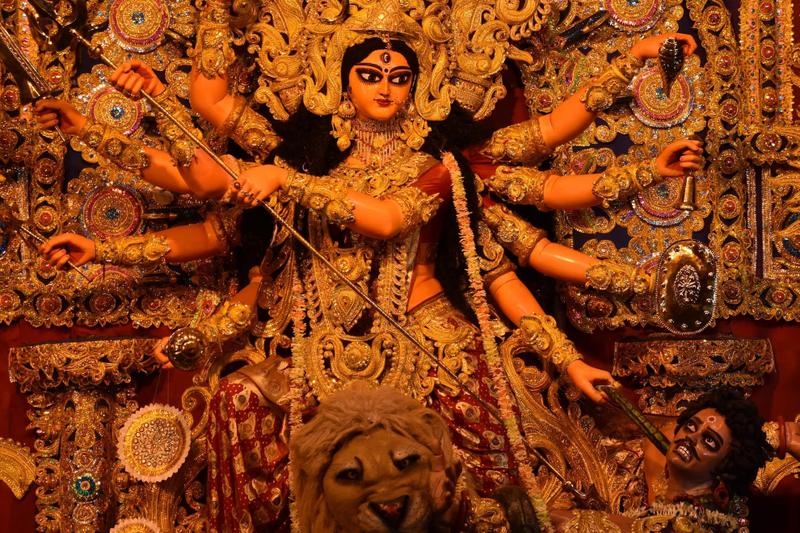People in Bengal are the most enthusiastic about Durga Puja. As it is believed that the Goddess Durga comes home with her children from Kailash after a year. This is a nine-day long festival in which the Goddesses in every form and incarnation are worshipped. People wear new clothes, exchange sweets and go pandal hopping with their loved ones. The day is significant from all the cultural and social aspects. The day also witnesses people connecting and reconnecting with their loved ones through Durga puja gifts. No matter where you are you can always send gifts to your loved ones in India from an Indian gifts portal and make them feel special. The sentiment of the day can only be understood if you know the story of the festival well.
The puja is an annual festival that celebrates the Goddess of power or Shakti, Goddess Durga. Durga in Sanskrit means – she, who is incomprehensible or difficult to reach. Devi Durga represents infinite power and female dynamism. The Puja originally was celebrated in the springtime, according to the Hindu calendar in the month of Chaitra. The Purana says that Maharaja Suratha of the kingdom of Kola initiated the worship of Maa Mahamaya buoyed by the wisdom of the Saint, Rishi Medha. But then Lord Rama before his legendary war which is one of the epics of India with the demon Ravana performed an Akal Bodhan (prematurely timed observation) in the Debi Paksha of the autumn season. Since then Durga Puja started to be observed in autumn (Sharat season) and is called Sharadiya Durgotsava.
These were according to the scriptures and now if we return back to the recorded history Durga puja was mostly held by the Zamindars. The first Durga Puja with a grand celebration following all the customs and traditions is recorded to be celebrated during the late 1500s. We find evidence and instances of these celebrations in the folklore. The folklore says that the Zamindars of Malda and Dinajpur unitedly initiated the first Durga puja in Bengal. Another source says that Raja Kangshanarayan of Taherpur or Bhabananda Mazumdar of Nadiya district organized the first Saradiya Durga Puja in 1606. Hence, we see that the Zamindars were the ones who organized the ‘Bari Pujo’. This means the puja of the house, as the ceremonies are so elaborate that it was not possible for the poor peasants to organize the puja. It took some time for the puja to be available for everyone and become a community puja which today is called the ‘Sarbojonin’ puja. The Durga puja has evolved and now there are traditional puja pandals that are the temporary framework or canopies of colorful fabrics. Then comes the themed pandals as well that portray a social message. People love to go and visit all these Pandals during the ten days of the puja. Many customs and rituals are performed in these pandals and enjoyed as a community. As delivering sweets becomes a crucial part of the celebration, you can send Indian sweets online. If you are willing to send flowers to Kolkata or cakes, you can do so via online cake delivery in Kolkata.
It is said that the Devas (The Gods from heaven) were driven away when they lost the war against the mighty Mahishasura. Mahishasura after great penance pleased Lord Brahma to have a boon so that he can be invincible Lord Brahma put a condition that his death can only be caused by a woman. Filled with pride Mahishasura agreed to this and started creating havoc. The Devas fled to earth and their accumulated rage caused the birth of Maa Mahamaya as Devi Durga Durgotinashini. She was created by the amalgamation of the powers of Gods and took powers and arms from them in her ten arms. She rode a Lion gifted to her by Lord Himalaya and she went to war with the Mahishasura. Mahishasura lost his life under the feet of the Mother Goddess when the Mother’s trident pierced his chest. It is in this form that the almighty mother’s divine idol is worshipped as the strength behind all – the Devas (Gods), the Rishis (Saints), the Yakshas (Mammon), Manabs (Humans), and Jibjagath (Living kingdom). She is the creator of Buddhi she is the Swaha and Swadha.
This is the history of the festival that we celebrate with a lot of vim and vigor. Thus, you can see how the festival has come from the threshold of the Zamindars to the lives of the common man. Now, we can too be a part of the celebration. The distinct rituals especially the ‘Dhunochi Naach’ and the ‘Sindoor Khela’ brings people together. If you want to know more about the customs and rituals of the festival, you can read our blog on the traditions and customs of Durga Puja. So, send gifts to Kolkata on Durga Puja and make your loved ones feel your presence this Durga Puja. There are multiple options of flowers and gifts to India from USA available on our website which makes it all the more easy to place your order and send gifts.




